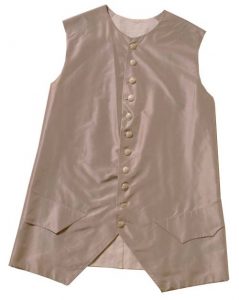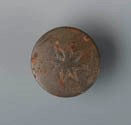Aaron Chapman // AMH 4112.001 – The Atlantic World, 1400-1900
The button. In the eighteenth century, buttons were an essential part of some articles of clothing, though not the same ones we might see today. On women’s clothing, buttons were an unlikely sight.[1] Primarily, you would expect to find buttons prominently featured on a man’s coat, waistcoat, and on his sleeves.

In particular, the waistcoat was a consistent article that featured buttons, which were at times closely spaced in order to display quite a number of them at once for the purpose of style.[2] The initial layer, consisted of a long shirt which would not itself be buttoned but rather worn loose or perhaps tied or cinched if necessary. In public, the waistcoat was worn over this shirt as part of a cultural understanding of what constituted being fully dressed.[3] Buttons would also be present on the longer coat, the outermost layer of clothing, which reached to the knee and was an essential piece of fashion for many.[4]
In the Glassford and Henderson’s Colchester ledger for 1760-1761 in the Ready Money accounts, buttons showed up consistently, with usually two or three purchases a month, though there were a couple months where they didn’t show up at all. It is hardly surprising given that buttons were the sort of thing you may need at any point in the year, rather than an item that was seasonally motivated. With a few exceptions – such as sleeve buttons, which were sold in pairs – buttons were listed as sold by the dozen or, less often, the half-dozen. This suggests that not only were they an item that could be needed at any time, but they were an item on which one would likely “stock up” in preparation for the sewing of new clothing and in anticipation of needing replacements, rather than one which would be purchased only at the time of need.[5]

For the most part, the ledger lists the buttons sold without any further description. There are a few instances of gilt, “mettle,” or glass button transactions listed, and occasionally it is indicated that the buttons are either “large” or “small,” but by and large, buttons are called simply that and nothing more. It is therefore difficult to say for sure exactly what material type of buttons were typically sold, though wood or bone are perhaps reasonable guesses if the few instances of “mettle” listed indicate that metal was a minority in button material and not the norm.[6]

The cost of buttons was small, the average was about one shilling for a dozen buttons, as long as they weren’t of a special material like gilt. The cost could vary wildly from transaction to transaction. In the Ready Money transactions for September 1761, for instance, three transactions adjacent to each other in the ledger list prices of 2 shillings 3 pence for a dozen buttons, then 1 shilling for a dozen buttons, and finally 1 shilling and 6 pence for two dozen buttons. This is a pretty significant swing in price within a short space of time. Perhaps some buyers were more adept at bargaining with Henderson than others or the purchase price variation represented different types of buttons?[7]
The button. Something most people hardly think about, yet it’s an essential component of many garments, both today and in the past. For the colonial Englishman, it could be both a statement of fashion and a functional means to hold a coat or waistcoat closed. Fortunately for us, it was also something that needed to be replaced often enough that we are blessed with the opportunity to see a glimpse of its purchase.
[1] “Men’s Clothing from the 1770’s” Dress-up Activity, Memorial Hall Museum Online, accessed November 10, 2016, http://memorialhall.mass.edu/activities/dressup/1770_man.html
[2] Ibid.
[3] “A Colonial Gentlemen’s Clothing: A Glossary of Terms,” Colonial Williamsburg history.org, accessed November 10, 2016, http://www.history.org/history/clothing/men/mglossary.cfm
[4] Ibid.
[5] Alexander Henderson, et. al. Ledger 1760-1761, Colchester, Virginia folio 10-13 Debit/Credit, from the John Glassford and Company Records, Manuscript Division, Library of Congress, Washington, D.C., Microfilm Reel 58 (owned by the Mount Vernon Ladies’ Association).
[6] Henderson, et. al. Ledger 1760-1761, Colchester, Virginia Folio 10 Credit, 11 Debit, 12 Debit, 13 Debit/Credit.
[7] Henderson, et. al. Ledger 1760-1761, Colchester, Virginia Folio 13 Debit.
